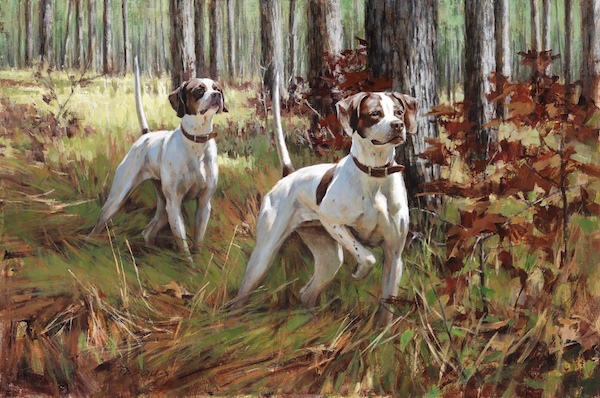
We first heard the term, “honoring a point,” during an anecdote shared with us about Pointers at a dog show: Breed judging took place in the outbuilding of a fairground, a popular hangout with pigeons. During the final “go round” of the Best of Breed class, several curious birds landed on a fence to watch the proceedings. The first Pointer in line screeched to a halt and went into a point, every Pointer behind him doing the same. Every dog behind that first Pointer “honored his point.”
A dog honoring a point (also called “backing” the point) is recognizing – or confirming – the first dog’s point. It can be done from any position, not just from behind the first pointing dog, but the honoring dog is expected to acknowledge the pointing dog as soon as it is seen, and the point is “stolen” if the second dog advances in front of the original pointing dog.
To non-sporting breed owners, this display of a breed doing what it was bred to do is a remarkable thing to see. “Honoring a point,” however, is important in both hunting and during field trials because dogs shouldn’t interfere with other dogs on point. If a judge sees a dog steal a point during a field trial, s/he’ll disqualify the dog, and if a dog does it while out hunting, hunting partners will not be happy and one is apt to find oneself hunting alone. Worse, some dogs don’t take kindly to another dog stealing their point. If a fight erupts between dogs, it is the “thief” of the point who will held at fault. One thing that can be hard to determine unless the find is witnessed, is the occasion of a divided find. That can happen when both dogs approach from a slightly different angle and lock onto point at virtually the same moment. In the end, fully trained dogs remain on point not only through the flush, but also through the shot. In the most advanced level of hunt tests, the honoring dog must remain on point throughout the retrieve by the pointing dog. Only a slight caution from the handler is allowed.
Dogs can be taught to honor a point, either with the presence of an experienced, or “broke” dog, or with something called a silhouette or a “backer” that resembles another dog and helps reinforce the dog’s natural honoring instinct.
Watch it in action below in this video posted by AVCI Rockolar (and check below the video for additional information about what you’ve seen)
We consulted Pointer owner, Marty Barnes Cornell, about the video who points out that the creeping in the video would be faulted in field trials and hunt tests in the United States (and yes, the #2 dog did steal the point.), and our other source, Phyllis, suggested that based on the low tail of dog #1, the scent cone was not firmly established, hence the creeping. Once point is established, the dogs should not relocate unless commanded to do so. Of course the problem often is that upland game birds are runners. Cornell had no doubt that the birds were running in the video. She adds that dogs in Europe are trained differently from those in the U.S. and are taught to drop at the shot. She knew of one dog trained in Europe to be retrained to stand to the shot in the U.S. and added that in the US, we seem to expect our dogs to point with a much higher tail carriage when on point.

Backing point in bird dogs comes natural I think
We think you’re right, Paul. The beauty of purebred dogs is the predictability which is a result of breeding for traits. Certainly birdiness and point honoring should qualify.